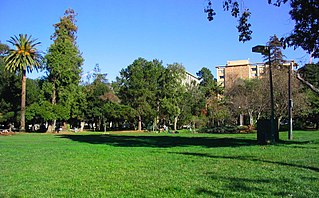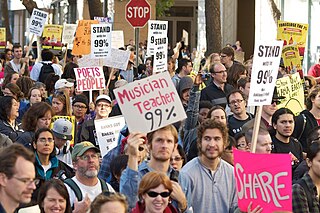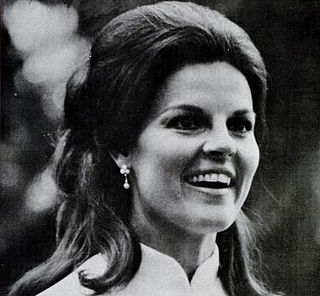Related Research Articles

South Park is a broad post-World War II development in the south-central area of Houston, Texas, a few miles south of MacGregor Park and directly south of the 610 Loop. According to the 2000 Census, the community has a population of 22,282. 81% of the South Park population is predominately African American, compared to 25% for the city as a whole. Houston's Martin Luther King Boulevard runs through the area. Reflecting its postwar origins, many streets in South Park are named after World War II battle sites and persons. In the 1980s and 1990s crime became a key issue for South Park. Katharine Shilcutt of the Houston Press said "South Park is an overgrown garden these days, its soil only able to be tilled by the most determined or the most desperate. It shows no sign that it will grow again any time in the near future."

People's Park in Berkeley, California is a park located off Telegraph Avenue, bounded by Haste and Bowditch streets and Dwight Way, near the University of California, Berkeley. The park was created during the radical political activism of the late 1960s.

Southampton Place, also known as Southampton, is a neighborhood located in Houston, Texas. The Southampton Civic Club Inc. is the homeowners' association.

Oak Forest is a large residential community in northwest Houston, Texas, United States. Oak Forest is the third largest group of subdivisions in Harris County.

Tanglewood is a neighborhood in western Houston, Texas, located off of San Felipe Road.
Near Northside is a historic neighborhood located in Northside, Houston, Texas. Near Northside is primarily occupied by people of Hispanic descent.
Blue Ridge is a community in Houston, Texas, United States that used to be a distinct unincorporated area in northeast Fort Bend County. The community, which was also known as Hobby, is located on a ridge of Oyster Creek, 16 miles (26 km) east of Richmond. The section of Blue Ridge within the Houston City Limits is known as the Fort Bend-Houston Super Neighborhood #41.

José Campos Torres was a 23-year-old Mexican-American and Vietnam veteran who was ruthlessly beaten by several Houston Police Department (HPD) officers that subsequently led to his death. He was assaulted by a group of on-duty police officers after being arrested for disorderly conduct at a bar in Houston's Mexican-American East End neighborhood. The officers convicted for the death of Torres, at the state level, received minimal sentencing; 1 year probation and a $1 fine. Torres' murder and sentencing sparked community outrage and lead to multiple community protests, with one gathering escalating to a riot. His death lead to advocacy based non-profits and HPD official's negotiations leading to the addition of policies addressing police-community racial relations.

The Consulate-General of Japan in Houston is Japan's diplomatic facility in Houston, Texas, United States. It is located in Suite 3000 at 2 Houston Center, which is located at 900 Fannin Street in Downtown Houston. The consulate serves Texas and Oklahoma.

The Northside is a district of Houston, Texas, United States. It is within the Greater Northside Management District.

Occupy Oakland refers to a collaboration and series of demonstrations in Oakland, California that started in October 2011. As part of the Occupy movement, protestors have staged occupations, most notably at Frank H. Ogawa Plaza in front of Oakland City Hall.

The Occupy movement began in the United States initially with the Occupy Wall Street protests but spread to many other cities, both in the United States and worldwide. This list article is a summary of occupy events that have occurred in cities in the United States.
Mary's, originally called Mary's, Naturally and sometimes referred to as Mary's Lounge, was an iconic gay bar located in the Montrose neighborhood in Houston, Texas, in the United States. The bar opened in 1968, and by the time of its permanent closing in November 2009, it was the oldest gay bar in Houston and one of the oldest in Texas. In 2011, OutSmart said that the bar "anchored" Houston's gay community in Montrose during its nearly forty-year history.

Lakes of Parkway is a gated community in western Houston, Texas, also the most southern community in the Energy Corridor. It has 888 lots. Peggy O'Hare of the Houston Chronicle stated in 2002 that the houses were "upscale".

On April 12, 2015, Baltimore Police Department officers arrested Freddie Gray, a 25-year-old African American resident of Baltimore, Maryland. Gray sustained injuries to his neck and spine while in transport in a police vehicle. On April 18, 2015, after Gray's subsequent coma, the residents of Baltimore protested in front of the Western district police station. Gray died the following day, April 19, 2015, a week after the arrest.

In 1977, the Texas State Bar Association invited country singer Anita Bryant to perform at a meeting in Houston, Texas. In response to Bryant's outspoken anti-gay views and her Save Our Children campaign, thousands of members of the Houston LGBT community and their supporters marched through the city to the venue in protest on June 16, 1977. The protests have been called "Houston's Stonewall" and set into motion the major push for LGBT rights in Houston.

On November 10, 2016, three days of protests in Portland, Oregon, turned into a riot, when a group of anarchists broke off from a larger group of peaceful protesters who were opposed to the election of Donald Trump as president of the United States.
The Humboldt Park riot was the second major conflict between Puerto Ricans in Chicago and the Chicago Police Department. The riot began on June 4, 1977 and lasted a day and a half. Following the shooting deaths of two Puerto Rican men, locals battled Chicago police officers in Humboldt Park and in the streets surrounding. The riot led the community to hold the Division Street Puerto Rican Day Parade, which started in 1978.
References
- ↑ "Moody Park: From the Riots to the Future for the Northside Community | Houston History Magazine".
- ↑ "Archived copy". Archived from the original on 2014-12-29. Retrieved 2014-12-29.CS1 maint: archived copy as title (link)
- ↑ "Moody Park: From the Riots to the Future for the Northside Community | Houston History Magazine".